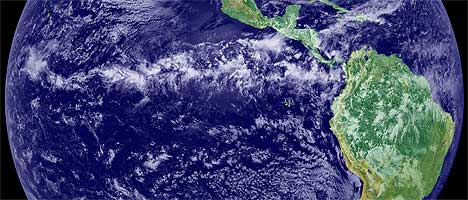Hydrological Cycle and Atmospheric Circulation
As climate changes, warming of the atmosphere will influence the hydrological cycle and atmospheric circulation in ways that could potentially have profound impacts on water resources around the globe. Work at GFDL over the past decade has improved our understanding of how circulation changes and changes in both precipitation and evaporation, particularly over land, are interrelated.
GFDL Research
Two important components of the atmospheric circulation response to human-induced climate change are the poleward movement of the midlatitude storm tracks and the subtropical dry zones with warming, and the response of tropical circulation and precipitation to differential warming of the Northern and Southern Hemispheres. Studies at GFDL have helped place the poleward expansion in the broader context of our understanding of how the latitude of the subtropical dry zones and midlatitude storm tracks are controlled. GFDL scientists have pioneered in studies of how the differential warming of the two hemispheres impacts tropical precipitation by moving tropical rainbelts towards the warmer hemisphere. This work has included a focus on the importance of aerosol forcing for this differential warming and shifts in tropical rainbelts and the dependence of model results on cloud feedbacks.
Changes in atmospheric circulation will have associated implications for the global distribution of water as the earth warms. Water vapor in the atmosphere increases with warming, especially over the oceans. As a result, even if the atmospheric winds do not change, the horizontal transport of water vapor by the atmosphere will increase. This will tend to enhance moisture convergence in relatively wet regions and increase the efficiency of water export in regions that are already dry, leading some to coin the phrase, “The wet get wetter and the dry get drier.” This connection between warming and water vapor fluxes is strongest over the oceans and regions with saturated soils, such as the subpolar continents. GFDL scientists are currently focusing on how to extend these intuitive arguments to semi-arid land regions to help interpret model simulations of climate change.
Research Highlights
- Opposing trends in winter Atmospheric River over the Western and Eastern US during the past four decades
- Identifying source of predictability for vapor pressure deficit variability in the southwestern United States
- Effect of Regional Anthropogenic Aerosols on Tropical Cyclone Frequency of Occurrence
- Importance of the Antarctic Slope Current in the Southern Ocean Response to Ice Sheet Melt and Wind Stress Change
- The driving of North American climate extremes by North Pacific stationary-transient wave interference
- Crucial role of sea surface temperature warming patterns in near-term high-impact weather and climate projection
- Poleward intensification of midlatitude extreme winds under warmer climate
- Kilometer-scale global warming simulations and active sensors reveal changes in tropical deep convection
- Atmospheric rivers over eastern US affected by Pacific/North America pattern
- Impacts of the North Atlantic biases on the upper troposphere/lower stratosphere over the extratropical North Pacific
- A mechanistic sea spray generation function based on the sea state and the physics of bubble bursting
- The relative role of the subsurface Southern Ocean in driving negative Antarctic Sea ice extent anomalies in 2016–2021
- A weakened AMOC may prolong greenhouse gas induced Mediterranean drying even with significant and rapid climate change mitigation
- Are multi-seasonal forecasts of atmospheric rivers possible?
- Sea level pressure trends: Model-based assessment of detection, attribution, and consistency with CMIP5 historical simulations
- Projected Changes in South Asian Monsoon Low-pressure Systems
Related Links
- Wet get wetter and dry get drier
- Land ecosystems and climate interactions
- Agriculture and Forestry
- Drought
- Aerosols and Climate
- Climate change and the hydrologic cycle




